This is going to be a slightly unusual Sunday Salon. The notion of doing a thorough salon on Henri Cartier-Bresson is too daunting. There’s simply far too much to cover—too much photography, too much of a life. To do even minimal justice to his life and work would require at least two—possibly three—normal salons. Instead, I’m going to narrow the scope of this salon.
I’m not going to discuss his life at all—not his early life as a painter, not his shift to photography, not his unsuccessful forays into cinema, not his early pre-war career, not his imprisonment by the Nazis during WWII nor his escape (on his third attempt), not his photo-documentation of the liberation of France, not his contribution as a founding member of the Magnum agency. Nor will I discuss Cartier-Bresson’s street photography, for which he is justly famous—so famous, in fact, that students of photography don’t even have to bother with his unwieldy name; the initials HCB are enough. At some point in the future I may return to those facets of his story, but today I’m going to narrow the salon to a single under-examined aspect of his work: the portraiture.
Why portraiture? Because as a genre, it’s more constrained than street photography. The possibilities are restricted by the simple fact that there is one specific subject, and that subject is generally aware of the photographer. Street photography, by its very nature, is fluid and so the street photographer also has to be fluid. Portrait photographers, on the other hand, remain in a semi-fixed orbit around the subject.
In the course of his long career HCB shot hundreds of portraits of artists, musicians, fashion designers, writers and philosophers. His portrait work is unique because his approach to photography was unique. Photographers take up the camera for a myriad of reasons. Some want to create beauty, some want to ‘capture’ beauty that already exists, some seek a form of self expression, some want to explore the technical aspects of photography, some just want to make a buck without doing any heavy lifting. For HCB, however, photography was an expression of philosophy. His philosophy shaped his approach to the act of photography—all of his photography. Whether it was shot on assignment or for his own pleasure, whether it was street photography or portraiture, his approach remained essentially the same. HCB didn’t differentiate between styles or modes of photography; he just shot photographs.
Because portraiture is photography pared down, we can see that approach—that expression of philosophy—more clearly. If you want to understand the work of Henri Cartier-Bresson, look first at his portraits, then at his street photography. Patterns emerge and the work becomes even more astonishing. Taking a photograph, he wrote, “is putting one’s head, one’s eye and one’s heart on the same axis.” When we look at his portraits, that head-eye-heart relationship is more evident.
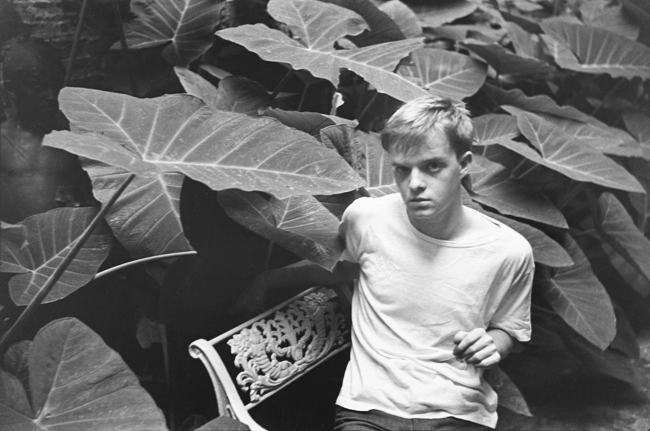
Cartier-Bresson famously compared himself to a Zen archer. The accuracy of that comparison is truly apparent to those familiar with Eugen Herrigel’s short monograph Zen in the Art of Archery. Although the book of that title wasn’t published until 1948—after the end of World War II—the ideas contained in it were first published in a German magazine as an essay in 1936—as the social situation in Europe began to drift back towards war. HCB didn’t read it until June 6, 1944—the same day, coincidentally, the Allied Forces landed in Normandy and began the liberation of Europe. At the time he was given a copy of the essay, HCB was an escaped POW hiding in Paris. After he recovered from the shock of the good news about the Allied invasion, he read the essay—and received an almost equally profound shock. Herrigel’s essay was to have a lasting effect on Cartier-Bresson and his work.
The central premise of the essay/book is that mastery of archery—or, one assumes, any activity combining concentrated thought and the delicate control of motor skills—comes when, through long practice, conscious thought is no longer required to hit the target. Herrigal wrote:
The archer ceases to be conscious of himself as the one who is engaged in hitting the bull’s-eye which confronts him. This state of unconscious is realized only when, completely empty and rid of the self, he becomes one with the perfecting of his technical skill, though there is in it something of a quite different order which cannot be attained by any progressive study of the art.
Herrigel’s kyujutsu instructor, Awa Kenzo (who, by the way, doesn’t appear to have actually been a practitioner of Zen), followed a doctrine called issha zetsumei, which is commonly translated as “one shot, one life.” The underlying concept of that doctrine is that the archer should put his entire lifetime of learning into every shot. Awa’s teaching stressed the process over the result. The result mattered only in terms of how well the process was performed. If the process was correct, the result would be correct. If the archer drew the bow properly and released the arrow properly, the mark would be hit. The archer could therefore be emotionally detached from the result, concerned only with the process. The process was perfected through long attentive practice.
For Cartier-Bresson, reading Herrigel’s essay was a moment of satori, of immediate enlightenment. It was as if his entire life had prepared him for that essay. It wasn’t that the essay changed HCB’s approach to photography. Rather, it validated what he’d already started doing by instinct. It gave him a theoretical underpinning—a set of principles—that clarified his approach. Reading the essay must have been like looking at a map of a familiar landscape; it didn’t change the terrain, but it more clearly revealed the route of the path he was on. I suspect it allowed him to relax, to be more at ease with the route he’d taken, to better appreciate the journey and become more detached from the pressure of arriving at the designated time and place.
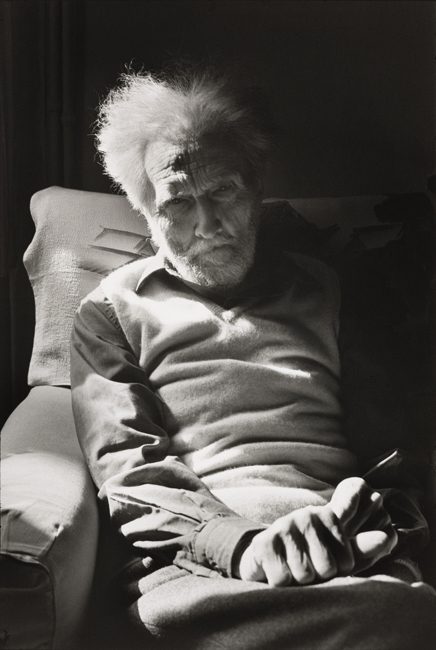
HCB had already, to use Herrigel’s terms, ‘become one with the perfecting of his technical skill.’ For a photographer, that ‘technical skill’ includes both an aesthetic and a mechanical component. HCB, who had originally intended to be a painter, had acquired the aesthetic skill in the two years he’d studied drawing, painting and composition under the tutelage of Andres Lhote—an artist famous for his passion for the geometry of form. Cartier-Bresson received poor marks in geometry as a boy, but once he perceived geometry as an expression of aesthetics the concept felt natural to him. He began to see the world in terms of how light revealed shape and form. Later in his life he would say that to take a photograph was “to find the underlying structure of the world—to revel in the pure pleasure of form” and that photography revealed “in all this chaos, there is order.”
In much the same way, HCB became a master of his tool of choice. He’d become a more-than-competent photographer using a bulky Krauss camera, but in 1932 he discovered the Leica II, the first Leica camera with an integrated rangefinder. The moment he picked up that smaller camera with its 50mm lens and looked through the viewfinder, HCB found a tool that suited him to perfection. The Leica became an extension of his hand, eye and mind.
Among the many reasons he was smitten with the Leica is because the arrangement of the viewfinder allowed him to see outside the frame. That gave him a fraction of a second to observe what might move into the frame. What made HCB unique was his ability to react instantly, without being encumbered by the thought process, to what was about to take place in the frame. Thinking, HCB said, “should be done beforehand and afterwards, never while actually taking a photograph.” That sentiment is perfectly in keeping with Awa Kenzo’s “one shot, one life” philosophy.
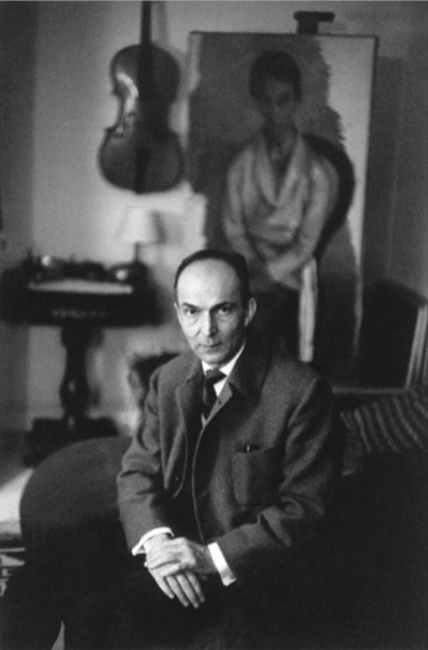
“With a language, everyone learns the grammar first,” Cartier-Bresson said. “In photography, one must learn a visual grammar. What reinforces the content of a photograph is the sense of rhythm, the relationship between form and values.” I have no idea what HCB meant by ‘values’ in this context, but his attention to the geometry of form is obvious in all his work, including his portraiture.
Cartier-Bresson used all the space within the frame to create a balanced form. In his portrait of Ezra Pound, the poet’s head-sized fist balances his fist-like face. The lightness of the chair and that burning bush of hair is balanced by the empty darkness. HCB’s ability to create such balance is all the more remarkable given his well-known refusal to crop an image.
His passion for the geometry of form is also revealed by a tendency to repeat or mirror shapes within the frame. For example, the shape of the cello behind composer Igor Markevich resembles the shape of the subject of the painting on the easel in front of it, whose pose is repeated by Markevitch. In his portrait of Truman Capote, the slant of the white bench is mirrored in the slant of the writer’s white shirt, both of which are echoed by the embracing slant of the leaves. The mirrored shapes formed by the arm of writer Louis-René des Forêts and the arm of the chair are obvious.
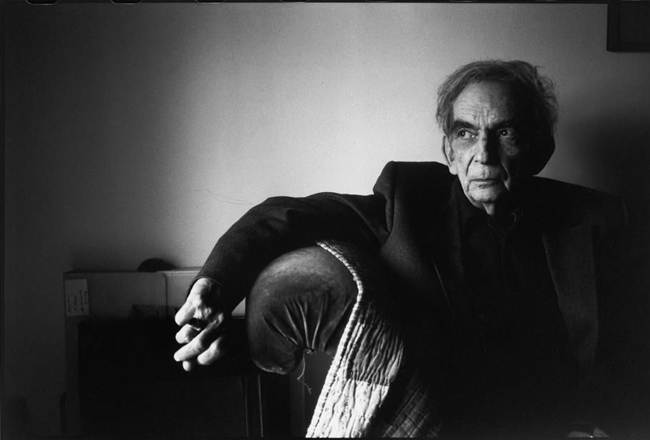
This isn’t to suggest HCB posed his subjects to develop those reiterations of form. Indeed, he often responded angrily at any suggestion that he posed his subjects. It’s much more likely that through long practice and consistent consideration of form, he observed a momentary pleasing configuration of geometry—perhaps only recognizing it subconsciously—and intuitively snapped the photograph. It’s not just a matter of coincidence; he does it too regularly for it to be coincidence. It’s a matter of being open to the possibility of coincidence and prepared to take advantage of it. When des Foréts drapes his arm over the sofa or when Capote slants his shoulder in a certain direction, HCB is ready—not poised in anticipation, which suggests a sort of tension, but rather in a heightened state of awareness. The subject moves, the finger presses the shutter, no thought is involved—just as the Zen archer’s arrow releases itself, so the Zen photographer’s shutter releases itself.
Perhaps because of that heightened awareness, Cartier-Bresson worked quickly, even when doing portraiture. Many of his subjects were surprised to find the portrait session over almost before they were aware it had begun. This was especially true after he became famous and his subjects had heard of HCB’s notion of the “decisive moment.” Perhaps they expected some drama, some sort of definitive ‘moment’ when HCB got The Photograph. It was, instead, as if HCB was just warming up, snapping a few practice frames to get in the mood—and then it was over.
In a 1991 interview in Le Monde Cartier-Bresson said “a portrait is like a courtesy visit of fifteen or twenty minutes. You can’t disturb people for any longer than that, like a mosquito about to bite.” That’s a very telling analogy—the portrait photographer as mosquito. Mildly annoying, buzzing about, sucking out the lifeblood of the subject. Perhaps the most revealing facet of that comment is HCB’s choice of the term ‘about.’ The mosquito is about to bite. The subject is waiting for that bite, expecting it, anticipating the arrival of that ‘decisive moment,’ unaware that HCB has already has already seen that moment, has already surreptitiously bitten the subject and satisfied himself.
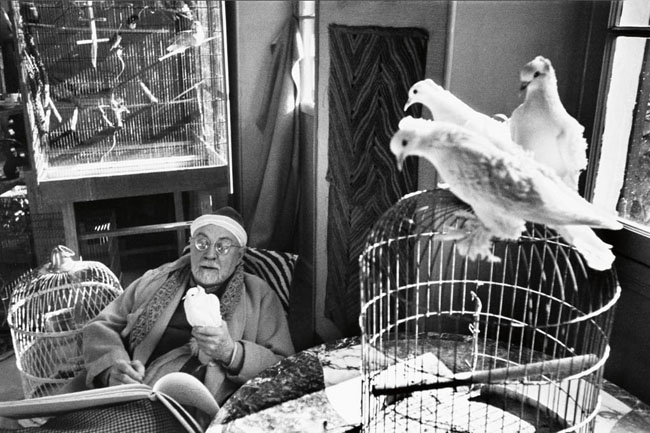
There is an understandable but unfortunate tendency when discussing Cartier-Bresson’s work to drift into the language of mysticism. Part of that, obviously, is because HCB himself tended toward the mystical. Of shooting portraits, he said “Above all I look for an inner silence. I seek to translate the personality and not an expression.” He also described the camera as “an instrument of intuition and spontaneity, the master of the instant which—in visual terms—questions and decides simultaneously.” That sounds pretty, but does it actually mean anything? Translating personality? Questioning and deciding simultaneously? I’m sure it meant something to HCB, but the meaning certainly isn’t universally clear.
Beneath all that mysticism is a simple truth. Cartier-Bresson had the right tool and he knew it so intimately he could operate it without the delay imposed by conscious thought. The design of the tool permitted him to see what was about to move into the frame, giving him the tiniest forewarning to which he could react without the delay imposed by conscious thought. He had a fundamental understanding of the geometry of form that was so deeply grounded in training and experience that he could compose an image, again, without the delay imposed by conscious thought. He developed a relaxed but heightened sense of awareness that allowed him to respond to what was happening within the frame, yet again, without the delay imposed by conscious thought.
In effect, Henri Cartier-Bresson’s brilliance was the result of a singular confluence of training, technology, and awareness. Each facet supported and enhanced the others. Would he have attained such greatness had he not been inspired by Lhote’s passion for geometry? Almost certainly not. Would he have attained it had he not discovered the Leica? Probably not. Would he have attained it had he not encountered Herrigel’s essay? Perhaps, because he’d already been moving in that direction. But he did train under Lhote, and he did find the Leica, and he did read the essay and took it to heart.
Toward the end of his life HCB engaged in a series of visits with Pierre Assouline, who eventually became his biographer. Early in their relationship Assouline asked the obvious question—do you still take photographs—and Cartier-Bresson dodged the question. Later in the visit came this exchange:
[J]ust as I was lifting my cup, he silenced me, looking straight at me for a moment. Then he half-smiled.
“A moment ago you asked me if I still took photographs…. Well, I’ve just taken one
of you, but without the camera—it’s just as good. The top of your glasses was exactly
parallel to with the top of the frame behind you—quite striking. I couldn’t miss
the chance of such perfect symmetry.”
One shot, one life—just as Awa Kenzo advocated. By the end of his life Henri Cartier-Bresson could shoot without the bow, without even the arrow, and still hit the mark.
